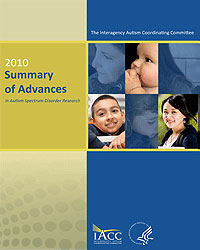Summary of Advances
In Autism Spectrum Disorder Research
2010
Question 1: Diagnosis - When Should I Be Concerned?
Implementing developmental screening and referrals: lessons learned from a national project.: In 2006, the American Academy of Pediatrics (AAP) issued guidelines on developmental surveillance and screening that included the recommendation that all children be screened for developmental delays at 9, 18, and 24 or 30 months of age. Read more.
Question 2: Biology - How Can I Understand What Is Happening?
Recommendations for evaluation and treatment of common gastrointestinal problems in children with ASDs: A panel of experts reviewed the medical literature on ASD and gastrointestinal (GI) disorders and developed a consensus report (Buie, Cambell, Fuchs et al., 2010) and recommendations for evaluation, diagnosis, and treatment (Buie, Fuchs, Furuta et al., 2010). While GI issues are commonly reported among people with ASD, the actual rate of these co-occurring issues and the proper methods for diagnosis and treatment are not well understood. Read more.
Question 3: Risk Factors - What Caused This To Happen and Can This Be Prevented?
Mutations in the SHANK2 synaptic scaffolding gene in autism spectrum disorder and mental retardation: Researchers discovered that mutations to SHANK2, a gene believed to play a role in maintaining the inner structure of the synapse, were present in people with ASD, as well as those with intellectual impairment. Without proper structure at the postsynapse – the receiving end of cellular communication – neural impulses cannot be properly sent. Read more.
Question 4: Interventions - Which Treatments and Interventions will Help?
Randomized, controlled trial of an intervention for toddlers with autism: The Early Start Denver Model: The Early Start Denver Model (ESDM) is the first comprehensive behavioral intervention for ASD shown to be effective for toddlers. This model uses a relationship-based approach that draws on elements of Applied Behavior Analysis (ABA) – a style of therapy that emphasizes breaking activities into small, measurable units that are then reinforced with reward. Read more.
Question 5: Services - Where Can I Turn for Services?
Can state early intervention programs meet the increased demand of children suspected of having autism spectrum disorders?: Early Intervention programs may be strained by the increase in demand for ASD services and additional resources will likely be necessary, according to reports from state program coordinators. In 2007, the American Academy of Pediatrics recommended that all children be screened for ASD at 18 and 24 months of age. Read more.
Question 6: Lifespan - What Does the Future Hold, Particularly for Adults?
While no articles directly related to Question 6: What does the future hold, particularly for adult? were selected by the committee for inclusion in the final 2010 IACC Summary of Advances in Autism Spectrum Disorder Research, three articles were nominated in this category and they are listed in the Full Listing of Nominated Articles.
Question 7: Infrastructure - What Other Infrastructure and Surveillance Needs Must Be Met?
Changes in autism spectrum disorder prevalence in 4 areas of the United States: Researchers analyzed changes in the rates of ASD in four states from 2000 to 2004 and found that the prevalence had increased by an average of 55 percent in the locations showing change. Using data collected by the Centers for Disease Control and Prevention (CDC) Autism and Developmental Disabilities Monitoring (ADDM) Network, researchers found that prevalence rates had increased significantly in Georgia and Maryland (38 percent and 72 percent increases respectively). Read more.




